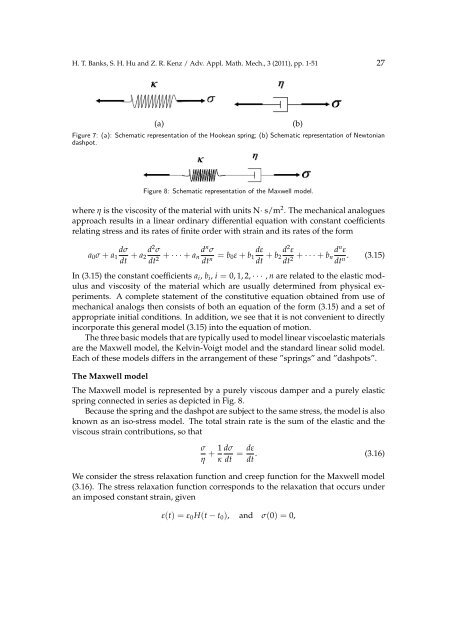A Brief Review of Elasticity and Viscoelasticity for Solids 1 Introduction
A Brief Review of Elasticity and Viscoelasticity for Solids 1 Introduction
A Brief Review of Elasticity and Viscoelasticity for Solids 1 Introduction
You also want an ePaper? Increase the reach of your titles
YUMPU automatically turns print PDFs into web optimized ePapers that Google loves.
H. T. Banks, S. H. Hu <strong>and</strong> Z. R. Kenz / Adv. Appl. Math. Mech., 3 (2011), pp. 1-51 27<br />
(a)<br />
Figure 7: (a): Schematic representation <strong>of</strong> the Hookean spring; (b) Schematic representation <strong>of</strong> Newtonian<br />
dashpot.<br />
(b)<br />
Figure 8: Schematic representation <strong>of</strong> the Maxwell model.<br />
where η is the viscosity <strong>of</strong> the material with units N· s/m 2 . The mechanical analogues<br />
approach results in a linear ordinary differential equation with constant coefficients<br />
relating stress <strong>and</strong> its rates <strong>of</strong> finite order with strain <strong>and</strong> its rates <strong>of</strong> the <strong>for</strong>m<br />
dσ<br />
a 0 σ + a 1<br />
dt + a d 2 σ<br />
2<br />
dt 2 + · · · + a d n σ<br />
n<br />
dt n<br />
= b dε<br />
0ε + b 1<br />
dt + b d 2 ε<br />
2<br />
dt 2 + · · · + b d n ε<br />
n<br />
dt n . (3.15)<br />
In (3.15) the constant coefficients a i , b i , i = 0, 1, 2, · · · , n are related to the elastic modulus<br />
<strong>and</strong> viscosity <strong>of</strong> the material which are usually determined from physical experiments.<br />
A complete statement <strong>of</strong> the constitutive equation obtained from use <strong>of</strong><br />
mechanical analogs then consists <strong>of</strong> both an equation <strong>of</strong> the <strong>for</strong>m (3.15) <strong>and</strong> a set <strong>of</strong><br />
appropriate initial conditions. In addition, we see that it is not convenient to directly<br />
incorporate this general model (3.15) into the equation <strong>of</strong> motion.<br />
The three basic models that are typically used to model linear viscoelastic materials<br />
are the Maxwell model, the Kelvin-Voigt model <strong>and</strong> the st<strong>and</strong>ard linear solid model.<br />
Each <strong>of</strong> these models differs in the arrangement <strong>of</strong> these ”springs” <strong>and</strong> ”dashpots”.<br />
The Maxwell model<br />
The Maxwell model is represented by a purely viscous damper <strong>and</strong> a purely elastic<br />
spring connected in series as depicted in Fig. 8.<br />
Because the spring <strong>and</strong> the dashpot are subject to the same stress, the model is also<br />
known as an iso-stress model. The total strain rate is the sum <strong>of</strong> the elastic <strong>and</strong> the<br />
viscous strain contributions, so that<br />
σ<br />
η + 1 dσ<br />
κ dt = dε<br />
dt . (3.16)<br />
We consider the stress relaxation function <strong>and</strong> creep function <strong>for</strong> the Maxwell model<br />
(3.16). The stress relaxation function corresponds to the relaxation that occurs under<br />
an imposed constant strain, given<br />
ε(t) = ε 0 H(t − t 0 ), <strong>and</strong> σ(0) = 0,

















